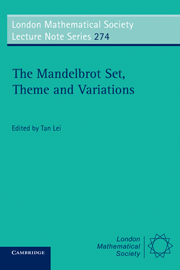Book contents
- Frontmatter
- Contents
- Introduction
- Preface
- The Mandelbrot set is universal
- Baby Mandelbrot sets are born in cauliflowers
- Modulation dans l'ensemble de Mandelbrot
- Local connectivity of Julia sets: expository lectures
- Holomorphic motions and puzzles (following M. Shishikura)
- Local properties of the Mandelbrot set at parabolic points
- Convergence of rational rays in parameter spaces
- Bounded recurrence of critical points and Jakobson's Theorem
- The Herman-Światek Theorems with applications
- Perturbation d'une fonction linéarisable
- Indice holomorphe et multiplicateur
- An alternative proof of Mañé's theorem on non-expanding Julia sets
- Geometry and dimension of Julia sets
- On a theorem of M. Rees for the matings of polynomials
- Le théorème d'intégrabilité des structures presque complexes
- Bifurcation of parabolic fixed points
- References
Preface
Published online by Cambridge University Press: 05 August 2011
- Frontmatter
- Contents
- Introduction
- Preface
- The Mandelbrot set is universal
- Baby Mandelbrot sets are born in cauliflowers
- Modulation dans l'ensemble de Mandelbrot
- Local connectivity of Julia sets: expository lectures
- Holomorphic motions and puzzles (following M. Shishikura)
- Local properties of the Mandelbrot set at parabolic points
- Convergence of rational rays in parameter spaces
- Bounded recurrence of critical points and Jakobson's Theorem
- The Herman-Światek Theorems with applications
- Perturbation d'une fonction linéarisable
- Indice holomorphe et multiplicateur
- An alternative proof of Mañé's theorem on non-expanding Julia sets
- Geometry and dimension of Julia sets
- On a theorem of M. Rees for the matings of polynomials
- Le théorème d'intégrabilité des structures presque complexes
- Bifurcation of parabolic fixed points
- References
Summary
Holomorphic dynamics is a subject with an ancient history: Fatou, Julia, Schroeder, Koenigs, Böttcher, Lattès, which then went into hibernation for about 60 years, and came back to explosive life in the 1980's.
This rebirth is in part due to the introduction of a new theoretical tool: Sullivan's use of quasi-conformal mappings allowed him to prove Fatou's nowandering domains conjecture, thus solving the main problem Fatou had left open.
But it is also due to a genuinely new phenomenon: the use of computers as an experimental mathematical tool. Until the advent of the computer, the notion that there might be an “experimental component” to mathematics was completely alien. Several early computer experiments showed great promise: the Fermi-Pasta-Ulam experiment, the number-theoretic computations of Birch and Swinnerton-Dyer, and Lorenz's experiment in theoretical meteorology stand out. But the unwieldiness of mainframes prevented their widespread use.
The microcomputer and improved computer graphics changed that: now a mathematical field was behaving like a field of physics, with brisk interactions between experiment and theory.
I mention computer graphics because faster and cheaper computers alone would not have had the same impact; without pictures, the information pouring out of mathematical computations would have remained hidden in a flood of numbers, difficult if not impossible to interpret. For people who doubt this, I have a story to relate. Lars Ahlfors, then in his seventies, told me in 1984 that in his youth, his adviser Lindelöf had made him read the memoirs of Fatou and Julia, the prize essays from the Académie des Sciences in Paris.
Information
- Type
- Chapter
- Information
- The Mandelbrot Set, Theme and Variations , pp. xiii - xxPublisher: Cambridge University PressPrint publication year: 2000
Accessibility standard: Unknown
Why this information is here
This section outlines the accessibility features of this content - including support for screen readers, full keyboard navigation and high-contrast display options. This may not be relevant for you.Accessibility Information
- 2
- Cited by
